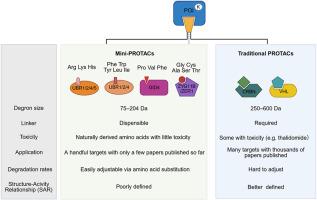强大的迷你protac:一种新兴的降解物
IF 5.9
2区 医学
Q1 CHEMISTRY, MEDICINAL
引用次数: 0
摘要
蛋白水解靶向嵌合体(Proteolysis-targeting chimera, PROTAC)是一种新兴的治疗策略,它通过重组泛素-蛋白酶体系统来破坏致病蛋白。尽管取得了巨大的进步,但PROTACs在开发和临床应用方面仍然面临着重大挑战。历史上第一个也是最简单的降解信号是单个氨基酸,导致n端规则蛋白水解途径,但其PROTAC适应性尚未得到充分探索。在这里,我们研究了n端规则途径在解决该领域一些主要问题方面的可行性,并介绍了由此产生的具有小、多样和可互换度的mini- protac。这种方法可能有助于克服与现有泛素连接酶相关的耐药性问题,并有助于增强药物样特性。最后讨论了mini-PROTACs相对于其他经典PROTACs的优点和局限性,为其临床应用提供参考。本文章由计算机程序翻译,如有差异,请以英文原文为准。

Mighty mini-PROTACs: an emerging class of degraders
Proteolysis-targeting chimera (PROTAC) is an emerging therapeutic strategy that rewires the ubiquitin-proteasome system to destroy pathogenic proteins. Despite tremendous progress, PROTACs still face significant challenges in their development and clinical application. The historically first and simplest degradation signal is a single amino acid, leading to the N-end rule proteolytic pathway, but its PROTAC adaptation has been under-explored. Here, we examine the feasibility of the N-end rule pathway in addressing some major issues in the field and introduce the resulting mini-PROTACs bearing small, diverse, and interchangeable degrons. Such an approach potentially helps overcome resistance issues associated with existing ubiquitin ligases as well as helps enhance drug-like properties. Finally, we discuss the advantages and limitations of mini-PROTACs compared to other classical PROTACs, which will facilitate their clinical applications.
求助全文
通过发布文献求助,成功后即可免费获取论文全文。
去求助
来源期刊
CiteScore
11.70
自引率
9.00%
发文量
863
审稿时长
29 days
期刊介绍:
The European Journal of Medicinal Chemistry is a global journal that publishes studies on all aspects of medicinal chemistry. It provides a medium for publication of original papers and also welcomes critical review papers.
A typical paper would report on the organic synthesis, characterization and pharmacological evaluation of compounds. Other topics of interest are drug design, QSAR, molecular modeling, drug-receptor interactions, molecular aspects of drug metabolism, prodrug synthesis and drug targeting. The journal expects manuscripts to present the rational for a study, provide insight into the design of compounds or understanding of mechanism, or clarify the targets.

 求助内容:
求助内容: 应助结果提醒方式:
应助结果提醒方式:


